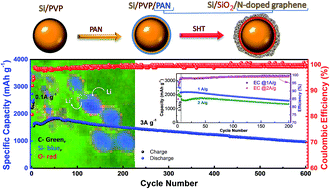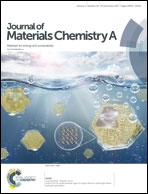Tailoring the chemistry of blend copolymers boosting the electrochemical performance of Si-based anodes for lithium ion batteries†
Abstract
Flexible and conductive carbon networks have been widely employed to overcome the stability degradation of highly sought-after Si-based anodes for Li-ion batteries (LIBs). However, little attention has been paid to the contact intimacy of such a network. In this contribution, we designed a polymer blend of polyvinylpyrrolidone (PVP) and polyacrylonitrile (PAN) which was self-assembled onto the surface of silicon nanoparticles (SiNPs) allowing for the generation of a very intimate coating of a silicon dioxide and nitrogen-rich carbon shell upon sluggish heat treatment. This methodology capitalizes on the surface interaction of PVP with SiNPs to provide a sturdy nanoarchitecture. The addition of PVP improves the stability and adhesion of PAN to the carbon-based matrix which surrounds the silicon particles leading to enhanced stability. In addition to being a very scalable fabrication process, our novel blend of PVP and PAN allowed for an electrode with high reversibility. When compared with a standard electrode Si/PVDF framework, this material demonstrated a significantly superior 1st discharge capacity of 2736 mA h g−1, high coulombic efficiency, and excellent cycling stability for 600 cycles at a high rate of 3 A g−1.

- This article is part of the themed collection: 2017 Journal of Materials Chemistry A HOT Papers


 Please wait while we load your content...
Please wait while we load your content...